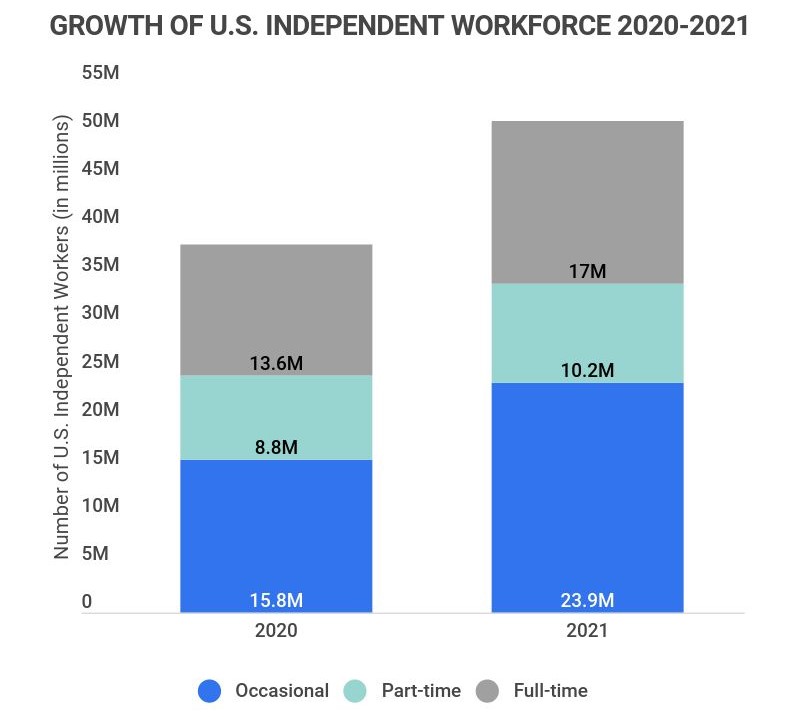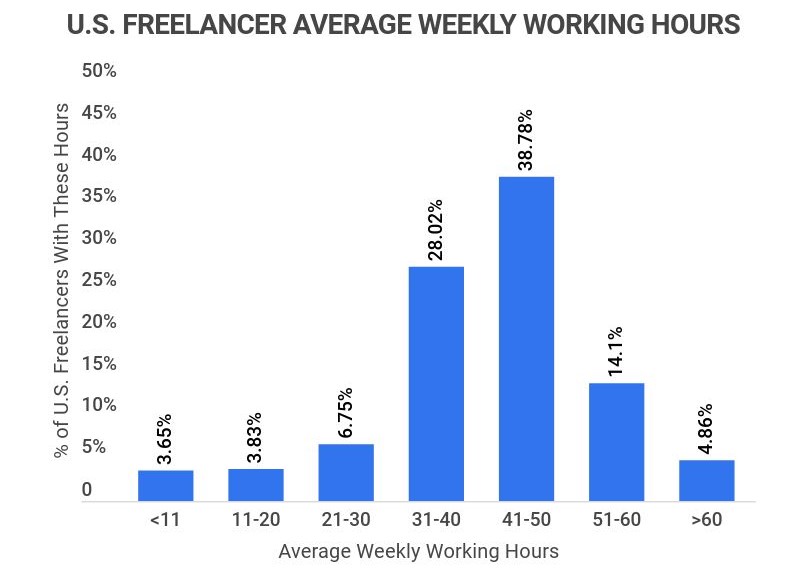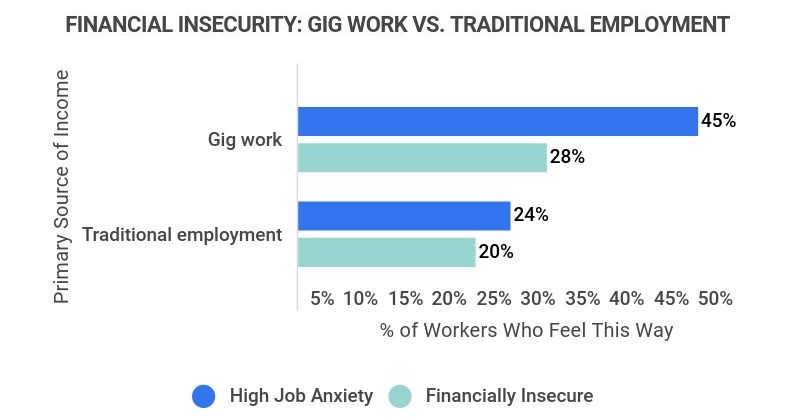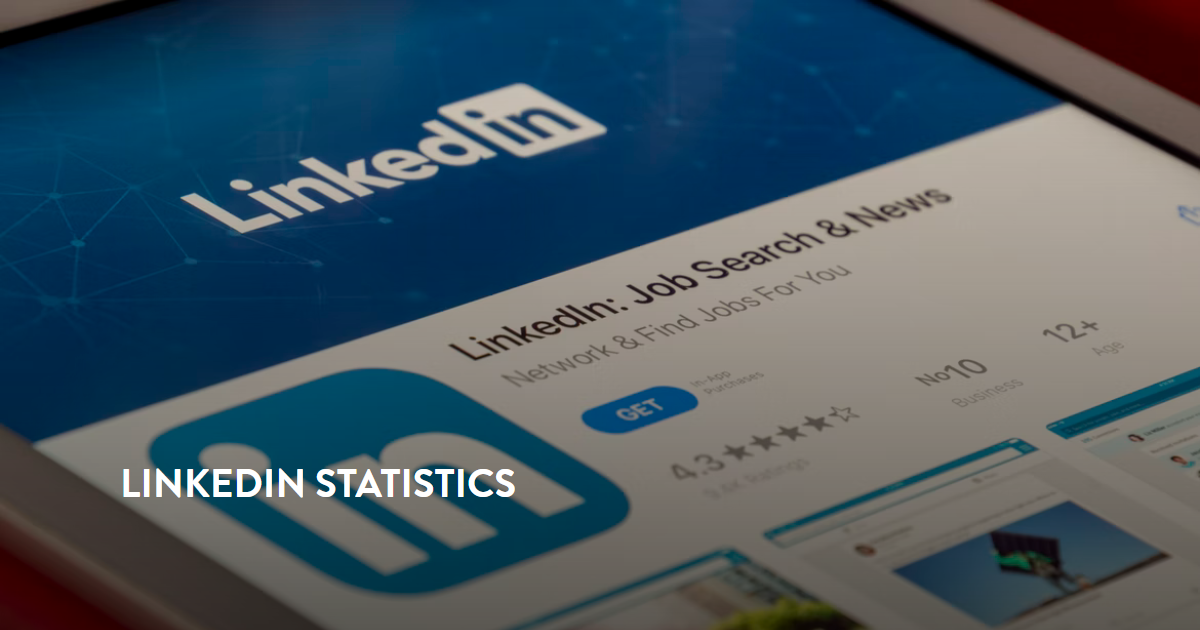Research Summary. Interest in gig work has grown immensely in the past few years, likely in part because of the COVID-19 pandemic. However, even as pandemic-era restrictions disappear, gig work continues to become more popular.
To learn more about the rise of the gig economy in the U.S., we’ve gathered all of the most essential statistics. According to our extensive research:
-
At least 59 million American adults participated in the gig economy over 2020, roughly to 36% of the U.S. workforce.
-
16% of U.S adults have earned money through an online gig platform at some point in their lives, and 9% earned income from online gig work in 2021.
-
Wages and participation for gig workers grew by 33% in 2020.
-
Gig workers contributed around $1.21 trillion to the U.S. economy in 2020, which is roughly 5.7% of the total U.S. GDP.
-
By 2023, experts predict that 52% of the American workforce will have spent some time participating in the gig economy.
For further analysis, we broke down the data in the following ways:
Gig Workers | Gig Worker Demographics | Industry Use of Gig Workers | Gig Economy Trends

General Gig Economy Statistics
Gig work makes up a surprisingly large portion of the U.S. economy. Especially since the start of the pandemic, more and more workers are making the switch or entering the gig work job market. Plus, the significance of gig work only continues to grow. Here are some insights our research uncovered:
-
The number of companies that fully operate on gig work increased by 554% between 2014-2018.
In 2014, there were only 26 digital companies that relied solely on gig work. However, in recent years that number has jumped to roughly 170 companies. In fact, over 30% of Fortune 500 companies report the use of freelancers.
-
As of 2019, the average full-time freelance worker works 43 hours per week.
While 70% of freelancers claim that they choose to work in a gig economy for an improved work-life balance, nearly 58% actually work more than 40 hours per week. Meanwhile, while working 41-50 hours is most common, working 31-40 hours per week was also common, with 28% of workers reporting those hours.
-
The number of independent workers in the U.S. increased by 34% from 2020 to 2021.
That’s over 13 million new workers contributing to the gig economy. And, this is highly connected to the pandemic, and in turn, the increase in remote work. 52% of workers who plan on quitting their job admit that they’re considering a freelance career instead.
-
Occasional independent workers grew by 51% from 2020 to 2021.
While the growth rate of independent workers is high across the board, it’s most evident in the rise of occasional workers. “Occasional” is defined as a regular indpendent work, but without set hours each week.
Growth of Indepedent Workers in the U.S. 2020-2021
Occasional Part-Time Full-Time 2020 15.8 million 8.8 million 13.6 million 2021 23.9 million 10.2 million 17 million Y-o-Y growth 51% 16% 25% -
As of 2021, there are at least 59 million gig work employees in the U.S.
And that’s a lot, considering the fact that there were only 38.2 million in 2020. Overall, these workers currently make up over a third of the U.S. workforce.


Gig Economy Statistics by Workers
Now that we’ve outlined the U.S. gig economy size, let’s address the gig work employees themselves. For the most part, many gig workers like their jobs, but that doesn’t mean there aren’t negatives. Here are the facts:
-
The average gig worker’s salary is only $29,050.
That’s 20% less than the average salary of a single American taxpayer, which is $35,977. However, this number can also be skewed by the fact that there is a huge pay disparity among gig workers. The bottom 75% of workers make far less than the top 10%.
-
84% of gig workers feel that their job gives them purpose.
Overall, gig workers have a positive view of their work and the future. In fact, a massive 97% of contractors feel they are happier than their more permanent counterparts. Plus, 94% also believe that their job is making a worthwhile contribution to the world.
-
44% of gig workers rely on their work as their primary source of income.
And of this 44%, an alarming 45% have an Economy Anxiety Index score over 50. This means that many of those who rely on the gig economy are riddled with deep economic anxiety.

Gig Worker Statistics by Demographics
Like any other line of work in America, the gig economy has noticeable disparities among different demographics. These disparities can be anything from pay to economic anxiety. Here are the facts:
-
Women in the gig economy make 10.5% less than their male counterparts.
That’s an average of 82 cents for every dollar a man makes. This means that the gig economy still suffers from the same gender inequality issues as the traditional job market.
-
Men are 72% more likely to participate in the gig economy.
Roughly 31% of men have earned money through the gig economy at some point in their lives, compared to 18% of women.
-
53% of gig workers between the ages of 18 and 34 rely on gig work as their primary source of income.
This makes sense demographically, as the largest number of gig workers are 18-34. Overall, 38% of gig workers are 18-34, 25% are 35-54, and only 11% are 55+.
-
Only 16% of gig workers have access to retirement plans.
That’s a far cry from the 52% of traditional employees who have access. Plus, 38% of gig workers report that they’re unable to save for retirement because they don’t generate enough income.
-
31% of Hispanic adults rely on the gig economy, which is more than any other demographic.
By contrast, only 27% of African Americans and 21% of White adults rely on the gig economy for work.

Gig Economy Statistics by Industry
As with anything related to the job market, some industries are more affected by the growing gig economy than others. After all, digital design jobs are far more likely to turn freelance than healthcare jobs. Here are some interesting facts we found:
-
The most popular industry for gig work is arts and design, with 77% of workers being freelancers.
The vast majority of those working in this industry are gig workers, but it isn’t the only industry with this trend. The second and third place for percentage of gig workers goes to the entertainment and construction industries, which are made up of 55% and 52% of freelancers respectively.
-
Only five of the 15 industries surveyed are made up of over 40% gig workers.
This seems to indicate that the prevalence of gig work is not evenly spread, as some industries rely on freelancers for the vast majority of their work while others barely use them. However, this disparity may change over the coming years.
Gig Economy Statistics Trends and Projections
Over the past few years, gig work has seen significant growth. In fact, experts predict that the U.S. gig economy will only continue to grow throughout the early 2020s. Here’s what we found:
-
As of 2021, 52% of workers who plan on quitting their job admit that they’re considering a freelance career instead.
And this increased interest would explain why the gig economy has grown by 15% within the last decade.
-
The gig economy has grown 15x faster than the traditional job market.
Overall job growth in the United States between 2010-2020 was only 1.1%, while the gig economy’s growth was a whopping 15%.
-
There were 23 million new gig workers in the U.S. in 2020.
2020 saw a huge rise in first-time freelancers and gig workers, not just in America, but the world over.
-
At least 48% of businesses hire freelancers.
And this isn’t surprising, as 90% of companies now see a mixed model based on gig work and remote work as crucial for a future competitive edge.
-
The U.S. gig economy is expected to have a Compound Annual Growth Rate (CAGR) of 17.4%.
In 2018, the gig economy was worth roughly $204 billion, but that number is expected to reach at least $455 billion in 2023.
-
It’s projected that there will be 86.5 million freelancers in the U.S. in 2027.
This would account for 50.9% of the U.S. workforce. The number is expected to reach 90.1 million in 2028.
Gig Economy Statistics FAQ
-
Is gig work good for the economy?
Gig work is good for the economy because it offers flexible, part-time job opportunities. On top of that, many gig workers are able to work remotely, and remote workers have been shown to be up to 47% more productive than traditional workers.
-
Who benefits from a gig economy?
Everyone benefits from a gig economy, and everyone experiences downsides too. For example, an employer can have the benefit of increased productivity and saving money from not having to pay benefits, while the gig worker receives a flexible schedule and increased motivation.
However, the lack of benefits can be seen as a downside for the worker, while flexible scheduling could be an issue for the employer.
-
How much is the gig economy growing?
The gig economy is growing significantly. In the past decade, it’s grown by 15% (that’s 15x more than overall job growth), and within the past year, wages and participation for gig workers grew by 33%.
-
What is the value of the gig economy?
As of 2021, the value of the gig economy is around $350 billion. Plus, with an expected CAGR of 17.4%, that number is expected to reach at least $455 billion in 2023.
-
What are the disadvantages of the gig economy?
The top three disadvantages of the gig economy are high economic anxiety, lack of benefits, and taxes. 45% of gig workers who rely on their gig work as a primary source of income have an Economy Anxiety Index score over 50. Plus, many gig work jobs don’t come with benefits and require you to pay all of your taxes during tax season.
-
What percentage of the economy is gig workers?
Approximately 9% of the American workforce participated in gig work over 2021. By value, gig workers contribute to about 5.7% of the U.S. GDP. It’s fair to say that the $350 billion gig economy comprises a significant portion of the current and future state of work in the U.S. and the world over.
-
The term “gig” comes from musicians who paid a set fee to perform one show. “Gig work” refers to similar short-term arrangements between an employer and a contractor who is hired to serve one particular function.
Gig work covers a number of job opportunities, from online freelance writers, to rideshare drivers, to tutors and personal trainers. If you’re being paid by the job, project, or specific instance of service, you’re likely participating in gig work.
Conclusion
With a growth rate of 15% over the past decade and an expected CAGR of 17.4% by 2023, the gig economy is becoming a major part of the U.S. job market.
Of course, this comes with its pros and cons. While 70% of freelancers appreciate the improved work-life balance, and 84% feel as though their job gives them purpose, there are also many with increased economic anxiety. 45% of those who rely on gig work as their primary income have an Economy Anxiety Index score over 50.
Therefore, the gig economy is a mixed bag of positives and negatives. Hopefully, its growth over the next few years will lead to some of these issues being resolved. After all, freelancing is started to be taken more and more seriously.
References
-
CNBC. “4 gig economy trends that are radically transforming the US job market.” Accessed on October 4th, 2021.
-
Freelancermap. “Freelancers also work long hours – 40+ hour working week.” Accessed on October 4th, 2021.
-
ValuePenguin. “The U.S. Independent Workforce Increased by 34% Since 2020.” Accessed on October 4th, 2021.
-
Anderson. “What is a Gig Worker?” Accessed on October 4th, 2021.
-
Inc. “Are Freelancers Happier Than Traditional Workers?” Accessed on October 4th, 2021.
-
Edison Research. “Americans and the gig economy.” Accessed on October 4th, 2021.
-
TheLily. “Women make less in the gig economy. A new study asked why.” Accessed on October 4th, 2021.
-
CNBC. “The gig economy is lacking in this one important respect.” Accessed on October 4th, 2021.
-
BLS. “Employment Projections — 2020–2030.” Accessed on October 5th, 2021.
-
Nasdaq. “How the Freelancing Boom is Driving Companies to New Business Models.” Accessed on October 5th, 2021.
-
Brodmin. “Gig Economy – The Economic Backbone of the Future?” Accessed on October 5th, 2021.
-
Statista. “Share of freelance workers in the United States in 2019, by industry.” Accessed on October 5th, 2021.
-
Pew Research. “The State of Gig Work in 2021.” Accessed on February 6th, 2022.
-
Statista. “Number of Freelancers in the United States From 2017 to 2028.” Accessed on February 16, 2023.






